Intel Core i7 4960X (Ivy Bridge E) Review
by Anand Lal Shimpi on September 3, 2013 4:10 AM EST- Posted in
- CPUs
- Intel
- Ivy Bridge
- Ivy Bridge-E
Visual Studio Compile
Our compile test is back and better than ever. With a much larger and faster SSD (Samsung SSD 830, 512GB), we're able to get more consistent compile times between runs. We're now using Visual Studio 2012 to compile Mozilla's Firefox project. The compile is multithreaded however there are periods of serial operation where performance is bound by the speed of a single core. The end result is a benchmark that stresses both single and multithreaded performance. Compile times are reported in minutes elapsed.
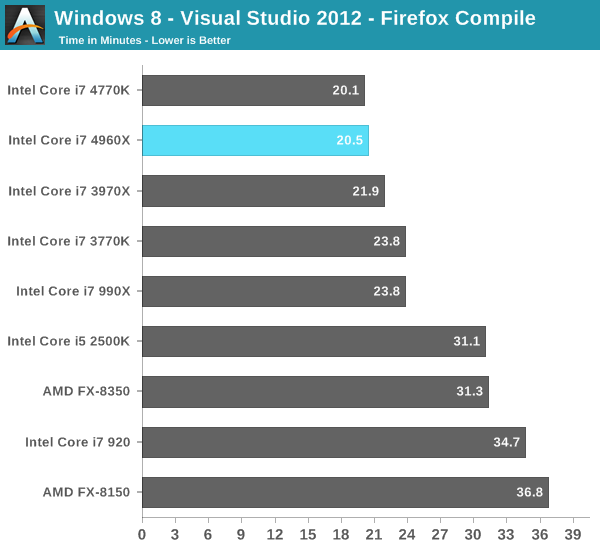
It's clear that IVB-E holds the advantage over Haswell when faced with heavily threaded workloads, but what about those workloads that are a good mix of both light and heavily threaded tasks? A medium-threaded workload if you will. It turns out our Firefox compile test is just that. Haswell's architectural improvements seem to do wonders for this test (under OS X as well), giving the 4770K a 16% lower compile time than Ivy Bridge. IVB-E on the other hand throws more cores at the problem, effectively equaling Haswell's performance but not exceeding it. In this case, if the rest of your applications are better threaded/demand more cores then IVB-E is the right solution for you. If, however, building Visual Studio projects is the most thread heavy thing you do then Haswell is a better option.
Photoshop
To measure performance under Photoshop CS4 we turn to the Retouch Artists’ Speed Test. The test does basic photo editing; there are a couple of color space conversions, many layer creations, color curve adjustment, image and canvas size adjustment, unsharp mask, and finally a gaussian blur performed on the entire image.
Time is reported in seconds and the lower numbers mean better performance. The test is multithreaded.
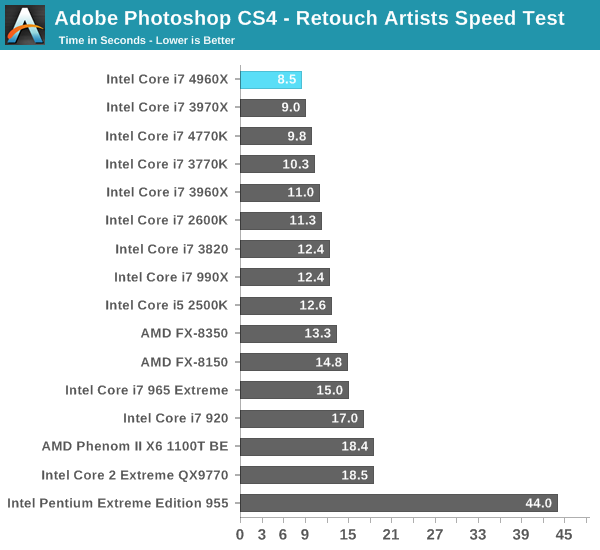
Our Photoshop test provides another example of an application with both lightly and heavily threaded behaviors. In this case, our Photoshop test favors the latter as the 4960X manages a 13% performance advantage over the 4770K. Once again the IVB-E advantage over SNB-E is around 5%.
File Compression/Decompression
The 7-zip benchmark is a CPU bound multithreaded integer workload that looks at 7-zip compression/decompression algorithms where the IO subsystem is removed from the equation:
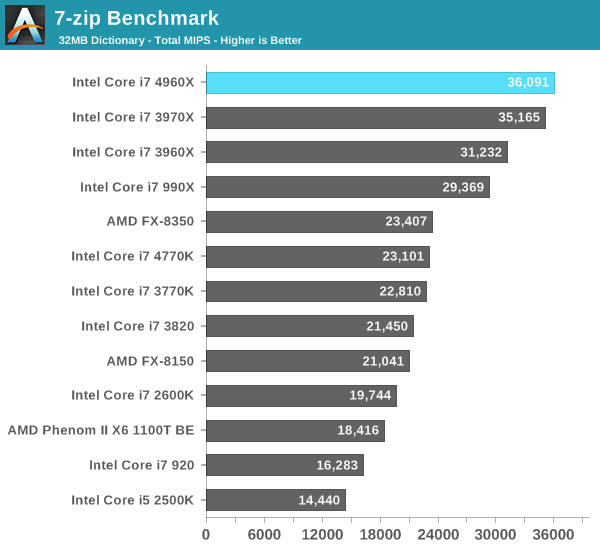
In its biggest advantage so far, the 4960X outperforms the 4770K by 56% in the 7-zip test. The IVB-E performance advantage compared to SNB-E shrinks to under 3% here. Heavily threaded integer workloads are also well suited for AMD's FX architecture. Here the FX-8350 is able to equal Haswell's performance.
Next up is our old Par2 test. Par2 is an application used for reconstructing downloaded archives. It can generate parity data from a given archive and later use it to recover the archive. Chuchusoft took the source code of par2cmdline 0.4 and parallelized it using Intel’s Threading Building Blocks 2.1. The result is a version of par2cmdline that can spawn multiple threads to repair par2 archives. For this test we took a 708MB archive, corrupted nearly 60MB of it, and used the multithreaded par2cmdline to recover it. The scores reported are the repair and recover time in seconds.
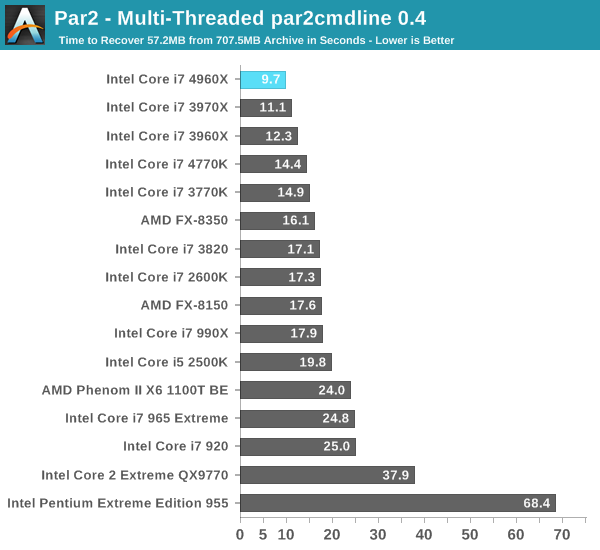
Here's another heavily threaded workload that does very well on the 4960X. We also see a rare situation where IVB-E increases performance over SNB-E by more than 10%.
Excel - Heavy Math
In our final CPU centric test we're running a monte carlo simulation on a large Excel spreadsheet. The process is well threaded.
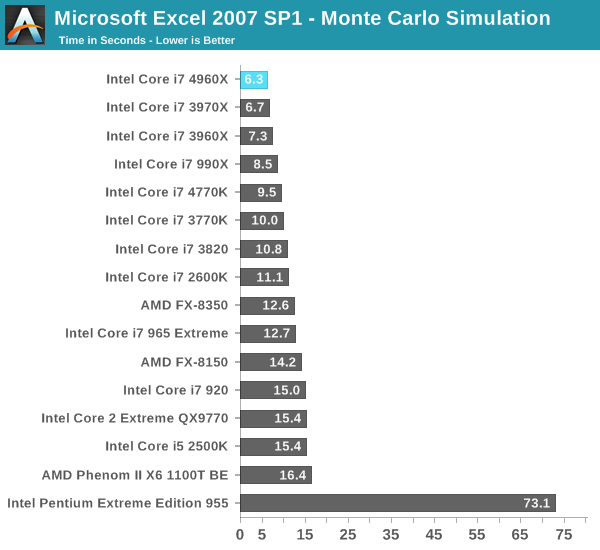
With 50% more cores, the 4960X delivers 33% better performance than the 4770K. If running multithreaded math workloads is up your alley, there's no alternative to the 6-core extreme edition parts.










120 Comments
View All Comments
ShieTar - Tuesday, September 3, 2013 - link
Whats the point? A 10-core only runs at 2GHz, and a 8-core only runs at 3 GHz, so both have less overall performance than a 6-core overclocked to more than 4GHz. You simply cannot put more computing power into a reasonable power envelope for a single socket. If a water-cooled Enthusiast 6-core is not enough for your needs, you automatically need a 2-socket system.And its not like that is not feasible for enthusiasts. The ASUS Z9PE-D8 WS, the EVGA Classified SR-X and the Supermicro X9DAE are mainboard aiming at the enthusiast / workstation market, combining two sockets for XEON-26xx with the capability to run GPUs in SLI/CrossFire. And if you are looking to spend significantly more than 1k$ for a CPU, the 400$ on those boards and the extra cost for ECC Memory should not scare you either.
Just go and check Anandtech own benchmarking: http://www.anandtech.com/show/6808/westmereep-to-s... . It's clear that you need two 8-cores to be faster then the enthusiast 6-cores even before overclocking is taken into account.
Maybe with Haswell-E we can get 8 cores with >3.5GHz into <130W, but with Ivy Bridge, there is simply no point.
f0d - Tuesday, September 3, 2013 - link
who cares if the power envelope is "reasonable"?i already have my SBE overclocked to 5.125Ghz and if they release a 10core i would oc that thing like a mutha******
that link you posted is EXACTLY why i want a 10/12 core instead of dual socket (which i could afford if it made sense performance wise) - its obvious that video encoding doesnt work well with NUMA and dual sockets but it does work well with multi cored single cpu's
so i say give me a 10 core and let me OC it like crazy - i dont care if it ends up using 350W+ i have some pretty insane watercooling to suck it up (3k ultra kaze's in push/pull on a rx480rad 24v laingd5s raystorm wb - a little over the top but isnt that what these extreme cpu's are for?)
1Angelreloaded - Tuesday, September 3, 2013 - link
I have to agree with you in the extreme market who gives a damn about being green, most will run 1200watt Plat mod PSUs with an added extra 450 watt in the background, and 4GPUs as this is pretty much the only reason to buy into 2011 socket in the first place 2 extra cors and 40x PCIe lanes.crouton - Tuesday, September 3, 2013 - link
I could not agree with you more! I have a OC'd i920 that just keeps chugging along and if I'm going to drop some coin on an upgrade, I want it to be an UPGRADE. Let ME decide what's reasonable for power consumption. If I burn up a 8/10 core CPU with some crazy cooling solution then it's MY fault. I accept this. This is the hobby that I've chosen and it comes with risks. This is not some elementary school "color by numbers" hobby where you can follow a simple set of instructions to get the desired result in 10 minutes. This is for the big boys. It takes weeks or more to get it right and even then, we know we can do better. Not interested in XEON either.Assimilator87 - Tuesday, September 3, 2013 - link
The 12 core models run at 2.7Ghz, which will be slightly faster than six cores at 5.125Ghz. You could also bump up the bclk to 105, which would put the CPU at 2.835Ghz.Casper42 - Tuesday, September 3, 2013 - link
2690 v2 will be 10c @ 3.0 and 130W. Effectively 30Ghz.2697 v2 will be 12c @ 2.7 and 130W. Effectively 32.4Ghz
Assuming a 6 Core OC'd to 5Ghz Stable, 6c @ 5.0 and 150W? (More Power due to OC)
effectively 30Ghz.
So tell me again how a highly OC'd and large unavailable to the masses 6c is better than a 10/12c when you need Multiple Threads?
Keep in mind those 10 and 12 core Server CPUs are almost entirely AIR cooled and not overclocked.
I think they should have released an 8 and 10 core Enthusiast CPU. Hike up the price and let the market decide which one they want.
MrSpadge - Tuesday, September 3, 2013 - link
6c @ 5.0 will eat more like 200+ W instead of 130/150.ShieTar - Wednesday, September 4, 2013 - link
For Sandy Bridge, we had:2687, 8c @ 3.1 GHz => 24.8 GHz effectively
3970X, 6c @ 3.5 GHz => 21 GHz before overclocking, only 4.2 GHz required to exceed the Xeon.
Fair enough, for Ivy Bridge Xeons, the 10core at 3 GHz has been announced. I'll believe that claim when I see some actual benchmarks on it. I have some serious doubts that a 10core at 3 GHz can actually use less power than an 8 core at 3.4 GHz. So lets see on what frequency those parts will actually run, under load.
Furthermore, the effective GHz are not the whole truth, even on highly parallel tasks. While cache seems to scale with the number of cores for most Xeons, memory bandwidth does not, and there are always overheads due to the common use of the L3 cache and the memory.
Finally, not directly towards you but to several people talking about "green": Entirely not the point. No matter how much power your cooling system can remove, you are always creating thermal gradients when generating too much heat on a very small space. Why do you guys think there was no 3.5GHz 8 core for Sandy Bridge-EP? The silicon is the same for 6-core and 8-core, the core itself could run the speed. But INTEL is not going to verify the continued operation of a chip with a TDP >150W.
They give a little leeway when it comes to the K-class, because there the risk is with customer to a certain point. But they just won't go and sell a CPU which reliably destroys itself or the MB the very moment somebody tries to overclock it.
psyq321 - Thursday, September 5, 2013 - link
I am getting 34.86 @Cinebench with dual Xeon 2697 v2 running @3 GHz (max all-core turbo).Good luck reaching that with superclocked 4930/4960X ;-)
piroroadkill - Tuesday, September 3, 2013 - link
All I really learn from these high end CPU results is that if you actually invested in high end 1366 in the form of 980x all that time ago, you've got probably the longest lasting system in terms of good performance that I can even think of.